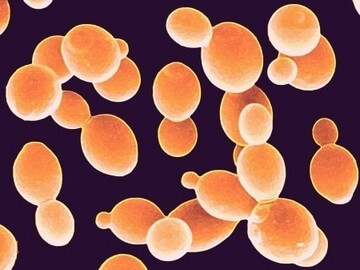Alcohol and Its Sources
 Figure X-1. A micrograph of yeast
Figure X-1. A micrograph of yeast |
When yeast cells metabolize sugar, they produce alcohol and carbon dioxide by a process called fermentation. If little oxygen is present, these cells produce more alcohol and less carbon dioxide. Figure X-1 shows living yeast cells.
Fermentation is the anaerobic conversion of various carbohydrates to carbon dioxide and an alcohol or organic acid.
Fermentation can occur spontaneously in nature—all that’s needed is sugar, water, a warm environment, and yeast (whose spores are present in air and soil).
Human experience with alcohol probably began at least 10,000 years ago with spontaneously fermented fruits or honey. Because all humans possess the enzymes to metabolize at least minimal amounts of alcohol, it’s reasonable to assume that humans have always had small quantities of alcohol in their diets. Very small amounts of alcohol are even produced by the microorganisms in our intestines.
Humans probably learned to make wine from fruits, mead from honey, and beer from grain about 5,000 years ago. In some areas, people made alcohol-containing dairy products.
Using simple yeast fermentation, they could not produce beverages with alcohol levels exceeding 16 percent—the point at which alcohol kills off the yeast, halting alcohol production. Later, seventh-century Egyptian chemists discovered how to use distillation to capture concentrated alcohol, which could be added to drinks to boost alcohol content.
Distilled alcoholic beverages (such as rum, gin, and whiskey) are called spirits, liquor, or hard liquor.
Distillation can yield more than just ethanol. Traces of other compounds, such as methanol, evaporate and then condense in the distilled product. Called congeners, these biologically active compounds helpt to create the distinctive taste, smell, and appearance of alcoholic beverages such as whiskey, brandy, and red wine.
But congeners are also suspected of causing or contributing to hangovers and may play a role in alcohol’s relationship to cancer.
Congeners are biologically active compounds in alcoholic beverages that include nonalcoholic ingredients as well as other alcohols such as methanol. Congeners contribute to the distinctive taste and smell of the beverage and may increase intoxicating effect and subsequent hangover.
Beer, wine, and liquor have different alcohol levels: Most beer is up to 5 percent alcohol; and hard liquor is typically 35 to 45 percent alcohol. Beer and wine are labeled with the percentage of alcohol, but hard liquor is labeled by “proof,” which is twice the alcohol percentage (an 80-proof whiskey is 40 percent alcohol).
Pure alcohol—a clear, colorless liquid used in chemistry labs—is 95 percent alcohol. (Even “pure” alcohol contains some water.) The beverage closest to pure alcohol is vodka, which is alcohol, water, and almost nothing else; gin is similar but flavored with juniper berries.
Scotch, rum, rye, whiskey, and other liquors have residual flavor traces of the grain from which they were fermented or flavors introduced during storage.
All liquors, however, offer little nutritional value besides energy. Beer and wine do contain unfermented carbohydrates and a trace of protein but, like liquor, have negligible minerals.
| Table X-1 Calories in Selected Alcoholic Beverages | ||
|---|---|---|
| Beverage | Serving Size | Approximate Kilocalories |
| Beer (regular) | 12 fl oz | 153 |
| Beer (light) | 12 fl oz | 103 |
| White wine | 5 fl oz | 121 |
| Red wine | 5 fl oz | 125 |
| Sweet dessert wine | 3.5 fl oz | 165 |
| 80-proof distilled spirits (gin, rum, vodka, whiskey) | 1.5 fl oz | 97 |
| Note: This table is a guide to estimate the caloric intake from alcoholic beverages. Higher alcohol content and mixing alcohol with other beverages, such as clorically sweetened soft drinks, tonic water, fruit juice, or cream, increases the amount of calories in the beverage. Alcoholic beverages supply calories but provide few essential nutrients. Source: U.S. Department of Agriculture, Agricultural Research Service. USDA National Nutrient Database for Standard Reference, release 20.2007. https://www.ars.usda.gov/main/site_main.htm?modecore=12-35-45-00. Accessed July 22,2014. | ||
With the exception of niacin in beer (a 12-ounce beer contains 1.8 milligrams of niacin, nearly 10 percent of the Daily Value), alcoholic beverages have negligible vitamins as well. Table SA.1 shows the number of calories in various alcoholic beverages.
One serving of alcohol, or a standard drink, is defined as 12 ounces of regular beer, 5 ounces of wine (12 percent alcohol), or 1.5 ounces (a “jigger”) of 180-proof liquor.
All contain roughly 15 grams (1 measuring tablespoon) of pure alcohol. Most health professionals who speak of “moderate alcohol intake” usually mean no more than one (for women) or two (for men) servings in a day. Moderate intake is not an average of seven drinks per week when there are six days of abstinence followed by seven drinks in one night! That’s binge drinking, and it’s dangerous.

